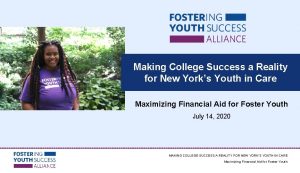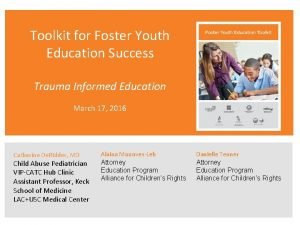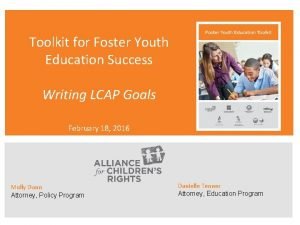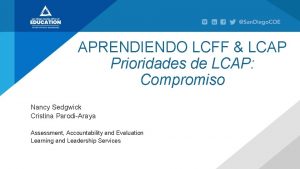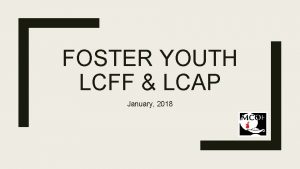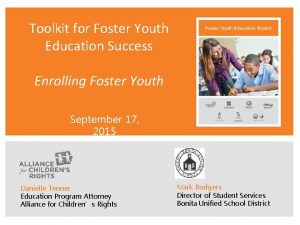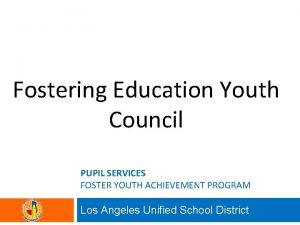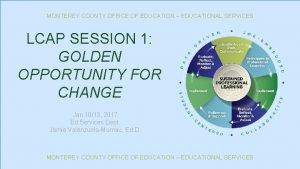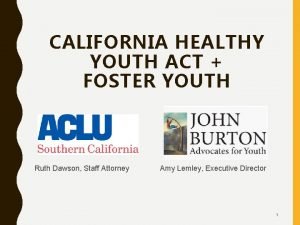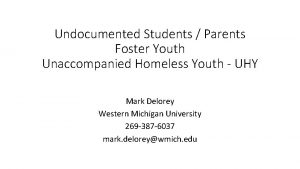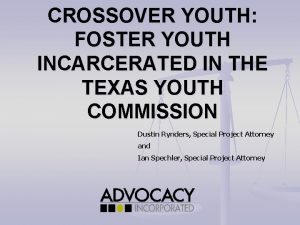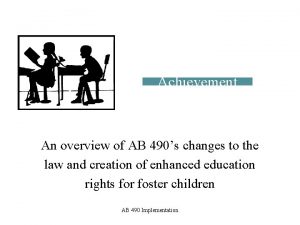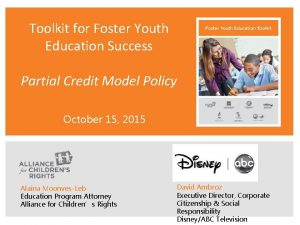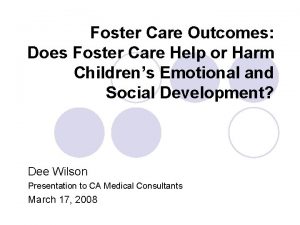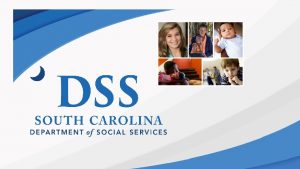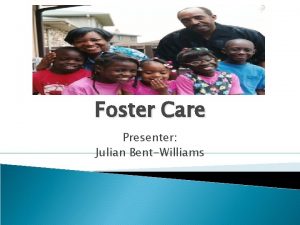Foster Youth Education LCAP Implementation for Foster Youth


























- Slides: 26

Foster Youth Education LCAP Implementation for Foster Youth Riverside County Office of Education March 27, 2015 CALIFORNIA DEPARTMENT OF EDUCATION Tom Torlakson, State Superintendent of Public Instruction

Foster Care Education Facts TOM TORLAKSON State Superintendent of Public Instruction • • • Are significantly more likely to change schools Are significantly more likely to be enrolled in the lowest performing schools Tested below basic and far below basic at twice the rate of students statewide Are significantly more likely to drop out than any other at risk student group. Have a 58% high school graduation rate, the lowest among atrisk student groups and as compared to a high school graduation rate of 84% for students statewide. Are identified for Special Education services at almost three times the rate of non-foster students Source: The Achievement Gap Report 2013: West. Ed Enter Created Date

Foster Youth Recent Legislation TOM TORLAKSON State Superintendent of Public Instruction • AB 12 Signed into law 2010 – Amends Welf. & Inst. Code § 11400 -11405 – Provides for extended eligibility for foster youth services if requested up to age 21 if certain conditions exist.

Foster Youth Recent Legislation TOM TORLAKSON State Superintendent of Public Instruction • AB 167/216 • Amends EC 51225. 3 High School Graduation requirements for foster youth. • Provides for high schools in CA to grant a diploma to a foster youth entering a high school in the 11 th or 12 th grade if that student has met the minimum state requirements for graduation, unless that student is reasonably able to complete the schools graduation requirements

Foster Youth Recent Legislation TOM TORLAKSON State Superintendent of Public Instruction • AB 97 School Finance Reform Adds EC Section 42238 -42251 – EC 42238. 01 • Defines Foster Youth for purposes of serving students with LCFF funding • Expands the existing definition of foster youth currently defined under EC 42920 -42925 • Shifts funding, planning and accountability decision making for foster youth to school districts.

Proposed Legislation TOM TORLAKSON State Superintendent of Public Instruction • AB 854 – Further refines the definition of foster youth. – Shift in service model – Changes roles of County Offices

Foster Youth Defined under LCFF TOM TORLAKSON State Superintendent of Public Instruction • A child or youth who is the subject of a petition filed under Welfare and Institutions Code (WIC) Section 300 (dependent of the court due to the presence or risk of abuse or neglect). This includes both children who are living at home while a dependent of the court as well as children who the court has ordered to be removed into the care, custody and control of a social worker for placement outside the home.

Foster Youth Defined under LCFF (cont’d) TOM TORLAKSON State Superintendent of Public Instruction • A child or youth who is the subject of a petition filed under WIC Section 602 (meaning a court has taken jurisdiction over a child and declared the child to be a ward of the court due to the child’s violation of certain criminal laws) and has been ordered by a court to be removed from home pursuant to WIC Section 727 and placed in foster care as defined by WIC Section 727. 4(d).

Foster Youth Defined under LCFF (cont’d) TOM TORLAKSON State Superintendent of Public Instruction • A youth between ages 18 and 21 who is enrolled in high school, is a non-minor dependent under the placement responsibility of child welfare, probation, or a tribal organization participating in an agreement pursuant to WIC Section 10553. 1, and is participating in a transitional living case plan.

Who is not defined as Foster Youth under LCFF? TOM TORLAKSON State Superintendent of Public Instruction • A child or youth who is in a “voluntary placement. ” Voluntary placements are not subject to a petition filed under WIC Section 300. • A child or youth who is living with relatives or friends and who is not a dependent of the court (i. e. is not subject to a WIC Section 300 petition). • A child or youth who is a ward of the juvenile court pursuant to a petition filed under WIC Section 602 who is either living at home or has been ordered to be placed in a corrective or rehabilitative facility but has not been ordered to be removed from his or her home into a foster care placement pursuant to WIC Section 727. 4(d).

What Now? TOM TORLAKSON State Superintendent of Public Instruction • LCFF Expands the definition of foster youth in California • Numbers of eligible youth in California may double • Increased demands on existing structures and systems • Schools will now be held accountable for educational outcomes for foster youth

What do we know about Foster Youth? TOM TORLAKSON State Superintendent of Public Instruction • A population served by multiple systems (often simultaneously): – California Department of Social Services – Child Welfare – Administrative Office of the Courts – Mental Health – County Probation – Community Based Organizations – Health Care system – Education Community

What do we know about Foster Youth? (cont’d) TOM TORLAKSON State Superintendent of Public Instruction • Many have had multiple home and school placements 24% have had at least two placements • Some struggle with trust and school engagement as a result • Often a skills or academic credit gap • Behavior issues- by history or observation • Substance Abuse • Special Education or special learning needs • Medical Issues • Trauma history

How do we serve Foster Youth? TOM TORLAKSON State Superintendent of Public Instruction • • Inter-Disciplinary Approach Multi-Systems Approach Team Based Comprehensive Case Management • Progress Monitoring • Flexible

Inter-disciplinary Approach to serving Foster Youth TOM TORLAKSON • Services approached based on: State Superintendent of Public Instruction – Student need – Inter-agency approach to service delivery requires interaction cross-systems – individuals from several disciplines working toward a common goal – team members have the additional responsibility of the group effort – includes the professionals but also the student, family and/or significant others

Multi-Systems TOM TORLAKSON State Superintendent of Public Instruction • Services approached based on: – What do we know about who is already working with the student? – What agencies or systems is the student connected with? – Who has educational rights? – Who has information on history? – What services are already in place? – How is the student responding to those services? – Where are the gaps?

Team Based TOM TORLAKSON State Superintendent of Public Instruction Team approach allows for: • • • Facilitates integrated interventions, instead of working on isolated tasks. Less overwhelming for the student if information related to intervention is shared across disciplines, rather than presented separately Can result in quicker decision making Redundancy or fragmentation of service can reduced or eliminated Increasing the cost efficiency of service.

Comprehensive Case Management TOM TORLAKSON State Superintendent of Public Instruction Comprehensive Case Management in schools includes: • A single point of contact in schools for the student in the coordination of services • Case manager is the liaison between the student, the school, home, government agencies and service providers to reduce duplication • Trust is built with the student, empowering the student to participate in decision making • Facilitates good identification of strengths, needs and goals • Can be a good source of contracting with the student and gaining agreement on roles and follow up.

Progress Monitoring TOM TORLAKSON State Superintendent of Public Instruction • Progress monitoring allows for: • The use of data to determine goals for learning that will take place over time. The student’s school performance including behavior and attendance is measured on a regular basis (weekly or monthly). Based on these measurements, services are adjusted as needed. the student’s progression of achievement is monitored and approaches are adjusted to meet the individual students needs Provides for regular, frequent review of progress and documentation of student progress for accountability purposes • •

Flexibility TOM TORLAKSON State Superintendent of Public Instruction • Process of good case management for foster youth would be • • Process need to be student and family centered. The monitoring and follow up needs to happen quickly and easily to help to build trust in the process and to aid in gaining agreements. Organizational and institutional barriers need to be removed. process can accommodate differences in background, training, and beliefs, as well as differences in the nature and philosophy of the instructional programs and practices already in place. Adjustments can be made easily; if something isn’t working, communicate and adjust. • •

How does this happen? TOM TORLAKSON State Superintendent of Public Instruction Where does the responsibility belong? • LCFF does hold schools accountable for educational outcomes for foster youth. – Consider all of the partners when developing the approach to case managing foster youth in schools – Assign a single person as a case manager – Develop your referral process – Intervention forms – Train your school on the process

Models to consider TOM TORLAKSON State Superintendent of Public Instruction • MTSS Structure MTSS is an integrated, comprehensive framework that focuses on Common Core State Standards, core instruction, differentiated learning, student-centered learning, individualized student needs, and the alignment of systems necessary for all students’ academic, behavioral, and social success.

Models to consider (cont’d) TOM TORLAKSON State Superintendent of Public Instruction • Positive Behavior Intervention Support (PBIS) – School-wide PBIS is a systems or tiered approach to establishing the social culture and behavioral supports needed for all children in a school to achieve both social and academic success.

Models to consider (cont’d) TOM TORLAKSON State Superintendent of Public Instruction • Interconnected Systems Framework (ISF) – ISF within PBIS builds from the established and effective platforms of PBIS to integrate school mental health programs and services for students with a higher level of need, such as individualized academic or behavior support. Aligns with PBIS and MTSS and is an approach that includes emphasis on: (1) effective teams that include community providers, (2) early identification and access to service through data based decision making, (3) ongoing progress monitoring, and (4) rigorous systems review for effectiveness.

Additional models to integrate TOM TORLAKSON State Superintendent of Public Instruction • Trauma Informed Practices – Trauma Informed Practices in schools integrates the following understandings include in the following domains in school: resiliency, relationships, selfregulation, academic competence, and health and wellness. These understandings aid school staff in understanding the needs of foster youth at a deeper level.

Questions? TOM TORLAKSON State Superintendent of Public Instruction • For additional information: Lisa Guillen, M. S. Education Programs Consultant California Department of Education (916) 327 -5930 lguillen@cde. ca. gov
 Foster youth college success initiative
Foster youth college success initiative Trauma informed care for foster youth
Trauma informed care for foster youth Formuö
Formuö Typiska drag för en novell
Typiska drag för en novell Nationell inriktning för artificiell intelligens
Nationell inriktning för artificiell intelligens Ekologiskt fotavtryck
Ekologiskt fotavtryck Shingelfrisyren
Shingelfrisyren En lathund för arbete med kontinuitetshantering
En lathund för arbete med kontinuitetshantering Adressändring ideell förening
Adressändring ideell förening Tidbok för yrkesförare
Tidbok för yrkesförare A gastrica
A gastrica Vad är densitet
Vad är densitet Datorkunskap för nybörjare
Datorkunskap för nybörjare Boverket ka
Boverket ka Debatt artikel mall
Debatt artikel mall Autokratiskt ledarskap
Autokratiskt ledarskap Nyckelkompetenser för livslångt lärande
Nyckelkompetenser för livslångt lärande Påbyggnader för flakfordon
Påbyggnader för flakfordon Kraft per area
Kraft per area Publik sektor
Publik sektor Kyssande vind
Kyssande vind Presentera för publik crossboss
Presentera för publik crossboss Vad är ett minoritetsspråk
Vad är ett minoritetsspråk Bat mitza
Bat mitza Treserva lathund
Treserva lathund Epiteltyper
Epiteltyper Bästa kameran för astrofoto
Bästa kameran för astrofoto
